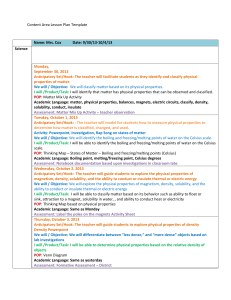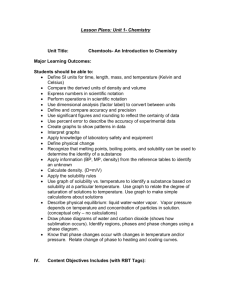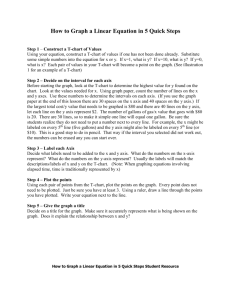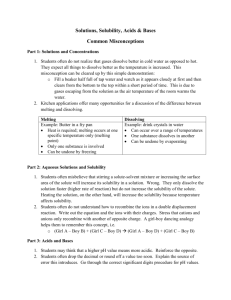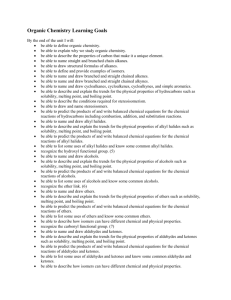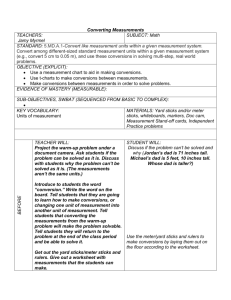WEDNESDAY LESSON PLAN - MsPetersensScienceScholars
advertisement
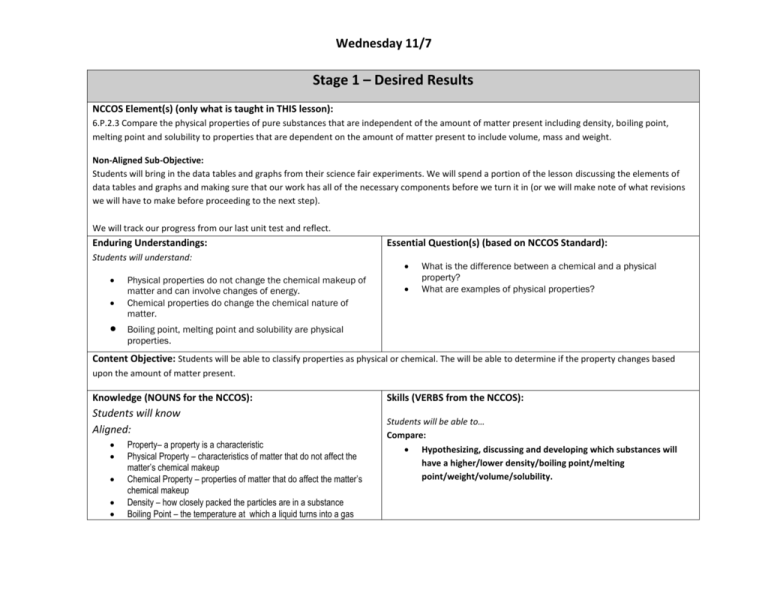
Wednesday 11/7 Stage 1 – Desired Results NCCOS Element(s) (only what is taught in THIS lesson): 6.P.2.3 Compare the physical properties of pure substances that are independent of the amount of matter present including density, boiling point, melting point and solubility to properties that are dependent on the amount of matter present to include volume, mass and weight. Non-Aligned Sub-Objective: Students will bring in the data tables and graphs from their science fair experiments. We will spend a portion of the lesson discussing the elements of data tables and graphs and making sure that our work has all of the necessary components before we turn it in (or we will make note of what revisions we will have to make before proceeding to the next step). We will track our progress from our last unit test and reflect. Enduring Understandings: Students will understand: Physical properties do not change the chemical makeup of matter and can involve changes of energy. Chemical properties do change the chemical nature of matter. Essential Question(s) (based on NCCOS Standard): What is the difference between a chemical and a physical property? What are examples of physical properties? Boiling point, melting point and solubility are physical properties. Content Objective: Students will be able to classify properties as physical or chemical. The will be able to determine if the property changes based upon the amount of matter present. Knowledge (NOUNS for the NCCOS): Students will know Aligned: Property– a property is a characteristic Physical Property – characteristics of matter that do not affect the matter’s chemical makeup Chemical Property – properties of matter that do affect the matter’s chemical makeup Density – how closely packed the particles are in a substance Boiling Point – the temperature at which a liquid turns into a gas Skills (VERBS from the NCCOS): Students will be able to… Compare: Hypothesizing, discussing and developing which substances will have a higher/lower density/boiling point/melting point/weight/volume/solubility. Melting Point – the temperature at which a solid turns into a liquid Solubility – how well a substance can be dissolved in a liquid; it is affected by temperature (higher temperature is beneficial for solids, detrimental for gasses in liquids) Volume – the amount of space something takes up Mass – the amount of matter in an object Weight – the force of gravity on an object Sub-Objective: X – axis – the horizontal axis on a graph Y – axis - the vertical axis on a graph Independent Variable – the variable that we can control and change Dependent Variable – the variable that we are testing for that we can’t control Real World knowledge Application (Where do they use this KNOWLEDGE in their real world): Each student weighs a certain amount. They know that Identifying and classifying properties based on type and dependence on the amount of matter. Evaluating the reasons that their classifications make sense. Real World Skills Applications (Where do they use these SKILLS in their real world): Students compare things every day – which food do they want for lunch? Which shirt is cuter? What activity is cheaper? They identify items or situations and use their knowledge to compare how certain aspects will affect an outcome. some objects weigh more than others. They have seen the word property before when we discussed the properties of waves. They have experienced density when we talked about how sound moves through mediums and on a smaller scale in a previous lab. They boil water to make pasta. They have seen chocolate, ice cream, ice, etc. melt. They have seen sugar or drink mix dissolve in water before. Stage 2 – Assessment Evidence Performance Task(s) and Product(s) to be assessed (What will they put in my hand to be assessed that they created individually): Students will fill out a table categorizing examples that I provide as chemical or physical changes. They will answer the following analysis questions and state their conclusion: Formal Assessment Grading Format(s) (How will I grade it, letting them know in advance how to receive every point in my grading scale): Students will receive 1 point for each example that they accurately categorize and list as a physical or chemical property. (15 points) 1. Were there any cards you had trouble classifying? Why/Why not? 2. Give an example of a physical change that was not listed above. 3. Give an example of a chemical change that was not listed above. Conclusion: 2-3 complete sentences on what you learned The will receive 1 point for answering each analysis question. (3 pts.) They will receive 1 point for writing 2 concluding sentences about what they learned. (1 point). Total: 19 points Students will turn in a data table and a graph of their science fair data. Stage 3 – Learning Plan Activating Strategies/Models (Hook +/- 10-15): Probe prior knowledge: I will put 3 examples of physical properties on a PowerPoint. As I introduce each image, we will talk about what the images have in common until we reach the conclusion that they are all physical properties. I will do the same with properties that are dependent upon the amount of matter present (including weight, mass, and volume). Hook: We will use TPS for our science starter (“When you pour honey into a cup of tea, why does the honey drop to the bottom?”). I will cold call groups after 2-3 minutes of discussion to share the answer that they wrote down collaboratively. I will take 3-4 responses. Procedures/Sequence (+/- 10 - 15 min): Students will individually complete a worksheet in which they will have to identify properties and physical or chemical. ( approximately 10 minutes) Enrichment, Hands-On, Student–Centered Activity (+/- 15 min): Students will be allowed to work with the person next to them to categorize the examples (15) that I give them on a T-chart. (approximately 15 minutes) Process: students must work on the first worksheet silently and independently. They can work on the second activity together so long as they are using whisper voices and are remaining on-task. They will hand in whatever they have done during class for a grade, so it is crucial that they stay focused and finish their work. Procedures/Sequence (+/- 25 min): Guided Notes – Students will take notes from an introductory PowerPoint presentation about properties that are affected by the amount of matter present (volume, weight, and mass) vs. properties that are independent of the amount of matter present. Materials needed: Physical/chemical changes worksheet Physical/chemical properties t-chart graphic organizer Physical/chemical properties example pictures (15) PowerPoint Differentiated guided notes LCD projector Summary (What we covered today +/- 3 min): Revisit our Science Starter question and explain it in greater depth using what we learned in today’s lesson. Differentiation: 1. Student EC: Partially filled in guided notes for EC students Preferential seating for student on 504 Strategic grouping of students for T-Chart. Extended time for worksheet and t-chart activity (with option to take it home for homework). Closure: Academic – Name 2 things that you learned today and one thing that you are still confused about. Social – How did you contribute during the physical/chemical change activity? Give a concrete example of one way that you worked well with your partner and one example of a way that you would like to improve. Reflection: A strength of this lesson was the logical sequence of keypoints. I also felt like the material had been scaled back to just the essentials. Less detail made it easier to understand and get through. Hook was supposed to help make material more relevant to students lives. However, one student in 3rd block asked halfway into the lesson “why does this matter”? I spent 5 minutes of a hook trying to make it relevant. I must have not made the connection. The drawing arrows on the mitochondria and chloroplast seemed to confuse students more than it helped. I wouldn’t do this next time. Perhaps it would have better to draw the organism itself – it makes more sense to see a plant absorbing carbon dioxide rather than a chloroplast. Lesson timing could have been better. I need to push faster through the warm up to save time on the back end. Ran out of time for the clock out – will give it as a warm up quiz to assess students understanding from today’s lesson.
